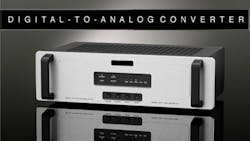With the increasing availability of ultra-highspeed digital-to-analog converters (DACs), a direct digital synthesizer (DDS) can generate waveforms exceeding 1 GHz. Until now, however, no higheroutput DDSs have been able to provide the desired modulation capabilities. Now, what is thought to be the first DDS RFIC with greater than 1 GHz output and direct digital FM and PM capabilities has been presented by Xueyang Geng, Fa Foster Dai, J. David Irwin, and Richard C. Jaeger from Alabama's Auburn University.
This 24-b, 5-GHz ultra-high-speed DDS operates at clock rates to 5 GHz and boasts the direct digital-modulation capabilities suitable for pulsed radar systems. The DDS can perform direct digital frequency and phase modulation with 24- and 12-b resolution, respectively. The DDS core, which occupies 3.0 x 2.5 mm2, consumes 4.7 W from a single 3.3-V supply. This DDS has more than 20,000 transistors.
When operating with a clock frequency of less than 5 GHz and within a 50-MHz bandwidth, the DDS has a measured worst-case spuriousfree dynamic range (SFDR) of -45 dBc. At an output frequency of 1.246258914 GHz, the 50-MHz narrowband SFDR is -82 dBc. The optimal Nyquist-band SFDR is -38 dBc with a 469.360351-MHz output using a 5.0-GHz clock frequency.
The DDS includes a 24-b RCA accumulator for phase accumulation, a 12-b RCA for phase modulation, and a 10-b segmented sine-weighted DAC for phase-to-amplitude conversion (PAC) as well as digital-to-analog conversion. Compared to a CLA adder, the RCA has a simple ripple architecture. It can be created by cascading one bit after another, which results in a very compact layout with short wire interconnections between stages. As a result, the RCA actually boasts a higher operation frequency than the CLA adder. See "24-Bit 5.0 GHz Direct Digital Synthesizer RFIC with Direct Digital Modulations in 0.13 m SiGe BiCMOS Technology," IEEE Journal Of Solid-State Circuits, May 2010, p. 944.
About the Author

Nancy Friedrich
RF Product Marketing Manager for Aerospace Defense, Keysight Technologies
Nancy Friedrich is RF Product Marketing Manager for Aerospace Defense at Keysight Technologies. Nancy Friedrich started a career in engineering media about two decades ago with a stint editing copy and writing news for Electronic Design. A few years later, she began writing full time as technology editor at Wireless Systems Design. In 2005, Nancy was named editor-in-chief of Microwaves & RF, a position she held (along with other positions as group content head) until 2018. Nancy then moved to a position at UBM, where she was editor-in-chief of Design News and content director for tradeshows including DesignCon, ESC, and the Smart Manufacturing shows.
